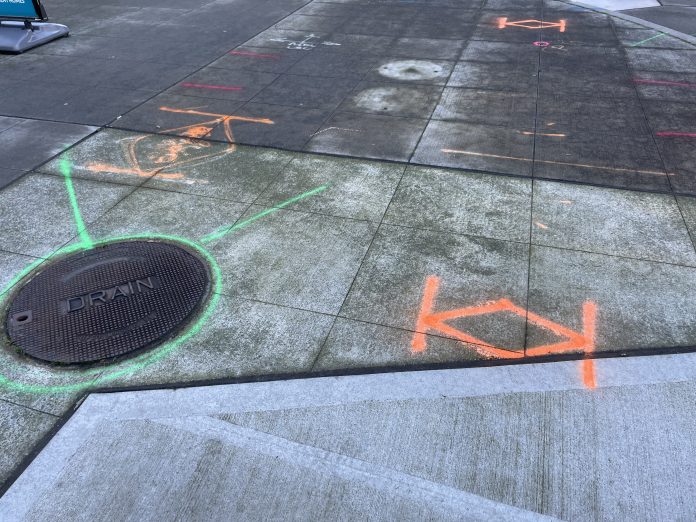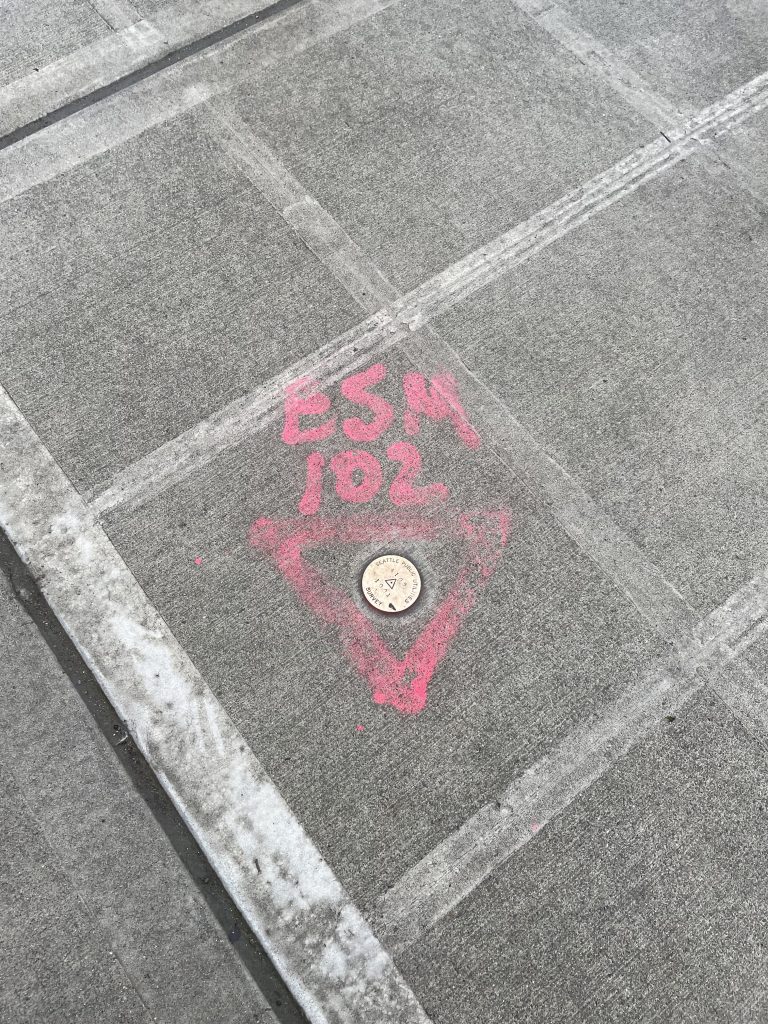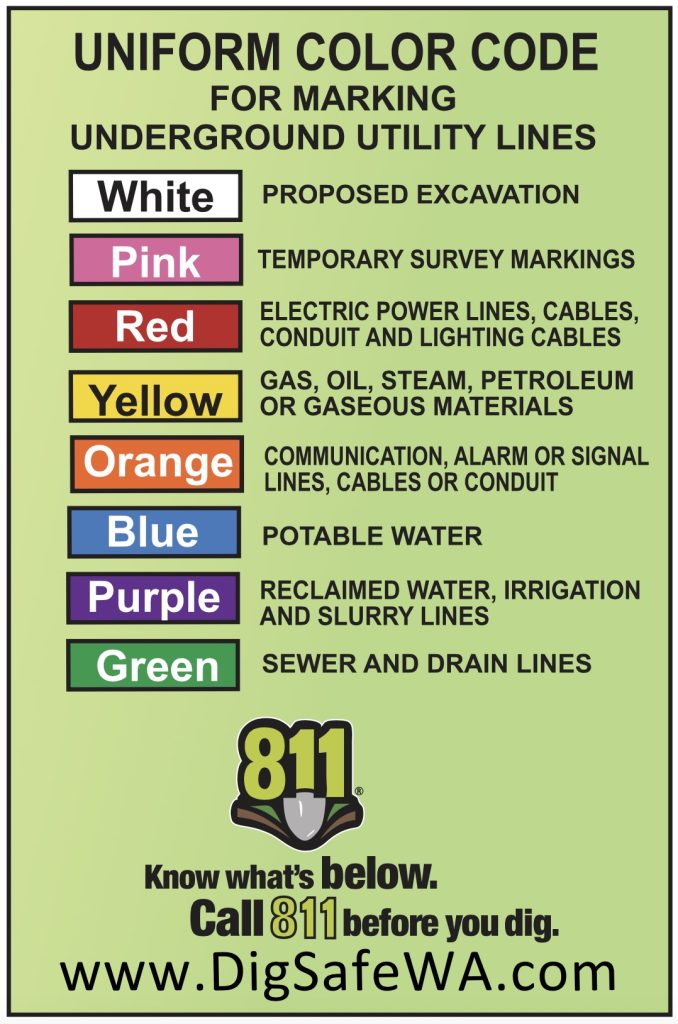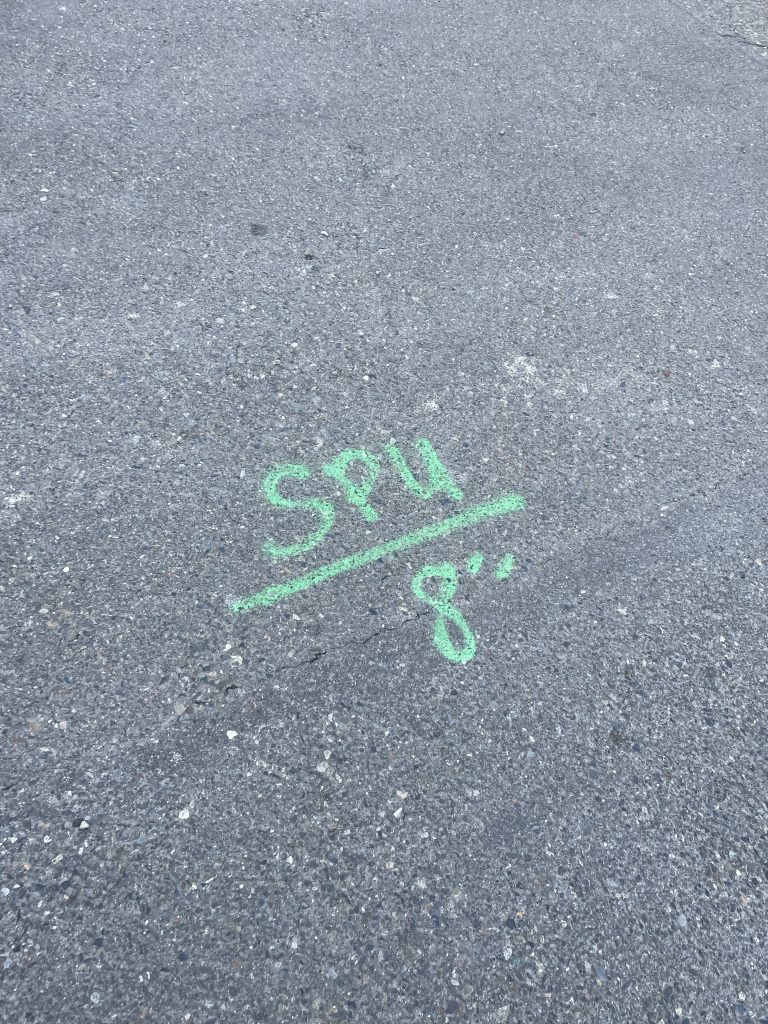
Given the amount of construction around town, Seattle’s sidewalks get painted a rainbow of colors. Many know that these markings are important for something, but the specifics seem indecipherable.
In short, the markings are for construction and utilities. The markings are coded according to the American Public Works Association’s Uniform Color Code. Of the most frequently sited, red is electric, yellow is for gas, and blue is potable or drinking water. Other markings that may be painted include green sewer lines and orange communication cables. Non-potable water sources like irrigation get marked in purple.
On the construction side, the limits of excavation are marked in white. Sometimes this will include “LOD” or “LOC” designating the limits of disturbance or construction depending if they are marking just a dig area or the entire site to be fenced off. Temporary survey markers get special treatment, highlighted in pink, to specifically avoid the reference points necessary to keep corners straight and walls plumb. Inside a site, one can often see survey posts are tagged in pink flags too.
There are a couple of variations to how utilities are marked. Many markings are simply put at the centerline of the conduit or pipe. These straight hash marks highlight that the pipe exists and any disturbance needs to avoid it. More elaborate markings, like the ones above, show the width of pipes and conduit, or occasionally an entire underground facility will be sketched out. But any marking is clear: dig with care.
Responsibility for avoiding underground utilities falls on the party doing the digging. From the markings, Washington requires careful digging within 24 inches to either side. That means hand tools within two feet from the furthest extent of the markings. Digging rules apply both to commercial contractors putting up a multistory apartment building, as well as homeowners getting their HGTV on.
I spoke with Laura Szczes, President of Double Z Media who represents Washington 811 for press questions. “Most of the consumer problems come from DIY decks and fences. Not the contractors. At the end of the day the contractors know what they’re doing,” she said.

Washington 811 is a central point of contact for homeowners and contractors to get utilities marked prior to construction. Washington’s 811 system is part of the Washington Utilities Coordinating Council (WUCC), a non-profit organization established to organize the state’s utility locate requests. These go through a contractor named One Call Solutions, who operate the 811 call center for Washington and a number of other states. The group’s website washington811.com has guides to safe digging, and links to make complaints or report damage.
The process of getting utilities marked is straight forward, given this consolidated point of contact. After the homeowner or excavator marks the site of the construction in white paint, and at least two business days before digging, they can call 811. Then each of the utilities will come out in turn and mark their lines. Easy peasy.
The companies locate utilities based on their records and a buried line detector. The utility staff will start from the known location of a wire or pipe in the street then follow along as the detector pings off conductive material buried underground. Working to the electric box or water main where maintenance becomes the owner’s responsibility, they will mark along the way in the correct color paint.
Szczes points out that there are limits to what’s being marked by utility companies. They do not have the list of what has been installed by previous occupants. “Septic, hidden fences, and heating are private features. Sprinkler systems are not part of 811. For those, you need a private utility locator.”
A lot of the information about 811 is geared towards reminding homeowners to call before putting in a deck. But concerned renters can call too. “You’re having the utilities come out and mark. So there’s no risk on the renter’s part to call. If the renter is afraid and is like ‘don’t knock out my cable’ it’s better to call.”
It is state law to call 811 before digging. There is no minimum excavation depth to avoid calling, and Szczes points out that they mark for realtors who are putting in For Sale signs. Better safe than sorry as the outcome of failing to identify utility lines are fines, along with the cost of repairs and damages should a utility be struck. And really, there is no reason for such peril, since Washington’s 811 system is simple and effective. And hopefully clear, now that we know what those colors mean.
Ray Dubicki is a stay-at-home dad and parent-on-call for taking care of general school and neighborhood tasks around Ballard. This lets him see how urbanism works (or doesn’t) during the hours most people are locked in their office. He is an attorney and urbanist by training, with soup-to-nuts planning experience from code enforcement to university development to writing zoning ordinances. He enjoys using PowerPoint, but only because it’s no longer a weekly obligation.



